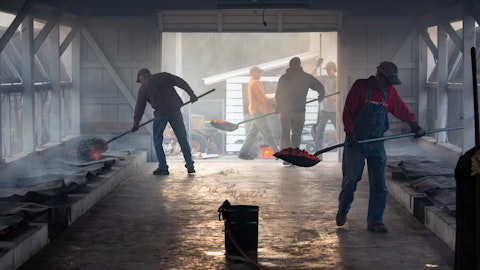Craig Nunez: In theory, there will be. This is a great question. It’s one that I don’t think anyone can answer, not just anyone in our team, but anyone in the industry. This is our view. These — if the CO2 sequestration business develops, as a business, globally, if it becomes a functioning viable business that has many players that are emitters that are capturing their emissions. It has developers that are capturing emissions of others and then being paid a fee to handle transport and then sequester the CO2 underground. If that happens, if the industry truly develops which will take years to do, I would guess, three, four, five or more years to develop if they develop, we believe that these two projects that we have with Oxy and with Denbury which is now Denbury Exxon we believe these projects will reach a point in time when there will be visibility and actually very predictable income from that could be quite material.
But there’s — it’s a bit of a conditional probability as to whether we’ll receive that type of income, because the first thing that has to happen is, the industry has to develop. Now, I do know that from what’s been announced publicly that both Exxon and Oxy are — or excuse me, Denbury and Oxy are both aggressively moving forward with their build-out of their CO2 sequestration activities. And they are active on our projects. But it’s — we really have to see the industry evolve, in order for these projects. And what I think will be other projects on the other 3.3 million acres we own of CO2 sequestration acreage in the Gulf Coast. I call these, — some of our call options on greatness. They cost us nothing to maintain. We actually get paid a nice small, — a small, but nice amounts of money by the operators to keep these leases.
And if the industry doesn’t play out then they may not play out either. But if the industry plays out, they could be quite significant to the company to NRP and it could be great. So there are call options on greatness that are currently out of the money if you — if that analogy resonates with you.
Unidentified Analyst: It does. Thank you. And I noticed as you point out there that Denbury and Oxy as a percent of your acreage, it’s a very small percentage. And are those potentially just the tip of the iceberg, or are those the best locations and therefore the lowest-hanging fruit, or could it be again…
Craig Nunez: So I would say that, those are two of our better locations, but we have a number of others, like it. And the tip of the iceberg question is interesting because, if the industry takes off, when you look at our acreage that we have. And you can look on a map on our website. And you can see the acreage we have it’s all in the places that you want acreage to be. It has the right geology. It has the right geographic location meaning, it’s close to emission sources. And when you combine that with the legal ownership we have which means that, in every state in the United States it is unclear it’s ambiguous as to what property owner has the right to grant to a lessee, the right to store CO2 in the subsurface. There’s questions as to whether it’s the mineral rights owner, maybe it’s the water rights owner and then — or maybe it’s the surface owner.
And in most places, there are not large contiguous tracks of acreage. When I say large, I mean, thousands of acres square — excuse me thousands of square — I mean hundreds of square miles or tens of square miles. There’s very few places where there are large contiguous tracks of acreage that are owned in fee, which means the owner owns all the rights from surface to the center of the earth. And therefore clearly is the one with the right to do it. Our 3.5 million acres where we have the sequestration right, is rather unique, because in our deeds we have the specific right to sequester in the subsurface and to use the surface that is necessary to exercise those subsurface rights, which means that for example, an operator, and we’ve had this happen already twice, is able to achieve with the stroke — single stroke of the pen, close to 100 square miles of contiguous acreage where they have both the absolute right to sequester the carbon.
So, we think that if this industry as a whole develops and moves forward — as perhaps Exxon may think it does, because of these large investments they’ve been making in carbon neutral initiatives as Oxy apparently feels they do because of all the investments, they’re making and then Denbury as well. If the industry develops, we think that more and more of our acreage is going to become attractive and will be likely sources of sequestration of CO2. But there’s a lot of ifs in there that we’re unable to predict and frankly, the developers who are putting all the capital out, are unable to predict right now. But it is — we are well positioned if in fact and we’re unique, in the nature of our ownership. We are well positioned and unique, if this industry develops.
So we’re watching it and cheering everybody on and hoping that it moves in the money.



